Granby All SaintsArchaeology
Exterior
 Tower Tower |
With 12th century fragments, this is a predominantly 13th and 14th century building, which was reduced in size and restored circa 1777 and restored again in 1888. It is built of thinly coursed rubble, and the north side of chancel has been rendered. It has slate roofs. It has a west tower, a three-bay nave with north and south porches and a chancel.
The square, four-stage tower has broad clasping buttresses to the first stage with a single lancet west window. In the second stage are two small round-headed Norman windows. A deep frieze with an ornamental band, a crenellated parapet with gargoyles and corner pinnacles forms the Perpendicular top stage where there are two-light, Y-tracery bell-chamber openings. There is a tablet on the west side of the tower which gives a date of 1777 when extensive repairs were carried out:
1777
The Revd Mr Hough
Vicar,
Thomas Marriott,
William Bateman.
Churchwardens
Joseph Musson &
William Bust,
Builders. |
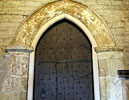 South doorway South doorway |
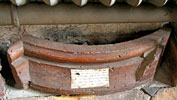 Terracotta window fragment Terracotta window fragment |
Within the 1958 south porch is a 13th century Early English heavily moulded doorway. To the right of the porch is a Perpendicular 3-light window. The chancel south side has 2 decorated windows of 2 and 3 lights the latter with trefoils and quatrefoils in the head. The 3-light decorated east window dates from 1888: fragments of the terracotta east window that it replaced now lie in the chancel. Restored 2-light windows with decorated tracery on the north side of nave (reset after the north aisle was demolished), and a third window is obscured by the north porch.
Interior
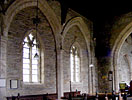 North wall, incorporating North wall, incorporating
the 14th century arcade |
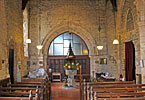 Mid-13th century Mid-13th century
tower arch |
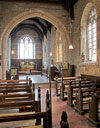 13th century 13th century
chancel arch |
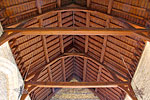 Nave roof Nave roof |
The 14th century north arcade is now in the north wall and has double-chamfered arches on octagonal piers with moulded capitals and demi-column responds. Masks form the intersection of the arches.
The double-chamfered tower arch, circa 1250, has circular responds with moulded capitals, and the double-chamfered 13th century chancel arch has octagonal responds.
The nave roof is arch-braced with big moulded tie-beams.
Medieval Cross Slabs
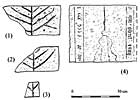 Cross slabs Cross slabs |
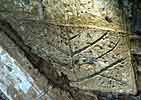 Cross slab 1 Cross slab 1 |
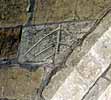 Cross slab 2 Cross slab 2 |
 Cross slab 4 Cross slab 4 |
Nos (1), (2) and (3) are all it appears parts of the same slab, a very unusual one in which it appears single incised lines and a scatter of dots represent a rather rudimentary cross shaft and branching foliage; it is more readily identifiable as a cross slab by the fact that (4) also has its cross shaft depicted as a single incised line, cf also Tuxford (1). (1) is set in the internal face of the west wall of the chancel on the north of the chancel arch c 4. m above the floor; (2) is on the opposite face of the same wall at about the same level and the smaller fragment (3) some distance above it, close to the roof. All are sketched - no dimensions could be taken.
(4) The lower part of a slab forming half of the internal head of the 17th century priest's door on the south of the chancel. The cross shaft is a single incised line and an attempt at a 'three-dimensional' pedestal base very rough and ready; in contrast the black letter border inscription is of reasonable quality, 'qui obit xxiiii' and 'dni M cccc xxx' are visible.
Descriptions and drawings of the cross slabs courtesy of Peter Ryder.
|